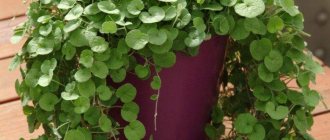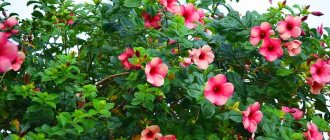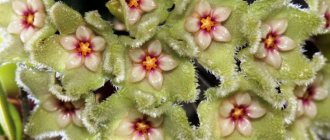Soil preparation
Dichondra grows best in deep, loose, well-drained soil, so the seed bed should be troweled or hoeed at least 15 centimeters deep.
If you plan to install a sprinkler system, do it before planting dichondra. Amend the soil with a general purpose lawn food, preferably organic.
Break up the clods, rake the surface and level it to a slight slope so that there are no depressions that will hold water.
Dichondra in landscape design
Most often, experts grow dichondra for vertical decoration of territories. This is applicable for both indoor floriculture and landscape design. The flower is planted in flowerpots and in all kinds of baskets, which imply the possibility of its growth and falling down. The plant is also used for landscaping and creating sculptures. It goes well with representatives of the Astrov family, for example, helichrysum.
Dichondra in landscape design
Dichondra is rightfully considered one of the most magnificent plants. It is used to decorate flower beds and create green walls, as well as compositions. In some cases, they are planted to replace lawn grass. The flower is unpretentious and frost-resistant, so there are no special difficulties when growing it.
Source
Landing conditions
Dichondra seeds need warm soil temperatures to germinate. It should be planted when the temperature is above 20 degrees.
Typically in most regions this is late spring or early summer. When soil temperatures are too cold, seed germination and lawn establishment are much slower and more maintenance is required.
Description
Dichondra belongs to the Convolvulaceae family and is a perennial creeping herbaceous plant. The name of this remarkable species comes from fruits consisting of two lobes (translated from Greek, the word “di” means two, and “chondros” means grain). The taxonomy of the plant has not yet been fully established, and fierce debate rages among scientists over the number of species that are included in this genus. Officially, there are 15 of them registered and they are all very impressive.
Nature has bizarrely scattered Dichondra around the planet. Most representatives are native to tropical and subtropical regions of North and South America, a few from Australia and New Zealand, and only one is native to China. The plant has been known for a very long time, it was found during the expedition of the same J. Cook, but it began to gain popularity only now.
The international exhibition “Flowers 2004” brought Dichondra a silver medal and worldwide popularity. This interesting new product literally blew up the world of landscape design, opening up enormous decorative opportunities for craftsmen. The expressive color palette allows you to create beautiful compositions and illusions. Long shoots are similar to silver rain or a waterfall. Sometimes they are identified with the green waves of the sea or river, covered with ripples from gusts of wind or a gentle stream.
Sowing seeds
When growing from seeds, you should scatter or sow at the rate of 450 grams per 46–92 square meters. meters. A higher concentration will give the rack density.
Rake the seeds to lightly cover them. A very shallow covering of peat moss or similar organic matter will help retain moisture until your seeds germinate.
Video review
Watch a short video about sowing dichondra:
I grew ampelous dichondra from seeds, just started to grow - autumn came, I couldn’t leave it outside, I brought it home, it seems to continue to grow. What's next? It says on the package that it is a perennial.
Dear Tatyana! My opinion about dichondra in winter is this. You can organize its wintering as a ground cover plant. I specifically ran and took a photo of mine.
This is my box with rosemary and marjoram; later a begonia with purple leaves was planted for decoration. I thinned and rejuvenated the marjoram in the summer. And in the second year, especially the summer on the balcony, dichondra has woven the entire surface of the box so that I can only get it out in pieces, like a pie, tearing off the edges. And marjoram, as you can see, is now suffering: it has nowhere to grow, so this beauty will urgently need to be “infringed” on the rights to the box with my herbs in the kitchen! I would like to note that as a ground cover plant it is quite pretty, and can also hang along the edge like a hanging plant. You can try placing one twig on the soil and lightly digging, pressing, and moistening. And try placing the remaining parts of the plant, on the advice of dear Lyudmila, on the loggia and in the basement. This way you will find the most optimal wintering regime for the plant. About my wintering of dichondra, it should be said that it takes place in the regime of 20-25 degrees and above, sometimes the plant is in a draft (ventilation in the kitchen), but in bright diffused light, the soil is moistened 2 times a week, the soil itself is loose and nutritious, moderately moisture-intensive, I don’t fertilize from November until about mid-February, the rest of the time I water it with fertilizer only while I’m not picking the greens for salads. I would also like to share my experience with the silver dichondra, since it was she who did not want to spend the winter in this mode. I explain this to myself by the plant’s greater demands on lighting. But I still don’t give up hope that with her I’ll get a “rug” like this in a box, because she’s even more beautiful. Dichondras (green and silver) also germinated differently for me: the germination rate of the green one was higher, the silver one was capricious, and this year, after overwintering with problems in the room, it died in a hanging pot on the balcony. But the green one survived the heat, it was underfilled in the box.
Watering
When growing dichondra, the seed bed should be moist but not soggy. The seed sprouts will die as soon as they dry out, so it usually takes several waterings 3-5 times a day to keep the soil moist.
Use a mist to avoid washing away soil and seeds. Proper watering is the most difficult and important step when growing any type of lawn.
In warm weather, the seeds will germinate in 1-2 weeks. The first leaves that appear will be long and narrow and will not look like true dichondra leaves. A week after most of the seedlings have grown, allow the soil surface to partially dry out between sprays.
Gradually increase the amount of watering each time you water, gradually decreasing the frequency. When you water, you need to water deeply, but not often - give dichondra flowers a good soak because they have a deep root system.
Watering too frequently will cause an invasion of diseases and weeds.
Reproduction
Dichondra silvery waterfall is propagated by seeds, using stem cuttings or layering. It is not propagated by dividing bushes due to possible death if the rhizome is damaged. With any method of growing seedlings, they should be watered with warm water, preferably settled.
Seeds
Seeds for seedlings begin to be sown from January to March. For this purpose, you need to choose a cup or container. On the soil of the container, you need to prepare “seed beds”, where the seeds are placed on the surface of moist, slightly acidic or neutral soil, and then sprinkled with a little sand or soil. The depth at which the seeds are sown should not exceed 0.5 cm. Before sowing the seeds, the soil must be treated with pesticides. The container is covered with a plastic bag and placed in a room where constant air humidity and a temperature of about 23°C are maintained. Humidity should be increased. In about eight days the first shoots will appear, and then the humidity inside the small greenhouse will need to be reduced. But it must be taken into account that high humidity is maintained by spraying, not watering.
The first leaves of sprouted seedlings differ from the leaves of the Dichondra silvery waterfall vine. After a few more days, real leaves will appear. After they appear, the plants can be pruned. Once the seedlings have germinated and reached 7 cm in height, the tops can be trimmed to encourage additional branching.
The transplant can be done for the first time after a month and a half, but this depends on weather conditions. You should wait until the threat of frost has passed. And the maximum decorativeness of the Silver Falls occurs after 3 months. The plant will retain its beauty all summer. Caring for seedlings is the same as for adult specimens. The seedlings become the most beautiful 3-4 months after germination. By the way, this vine can be propagated by seeds directly on lawns, but this is how it is propagated in warm areas.
Stem cuttings
It is easier to propagate the plant using stem cuttings. For this purpose, branches about 6 cm long are prepared, on which there are three leaf nodes. For rooting, each stem is stuck into a soft, slightly acidic substrate to a depth of 3 cm. After this, the cuttings are watered with a solution of a growth stimulator and covered with polyethylene, and placed in a lighted place (preferably on the windowsill of a south-facing window).
It is important to know: for rooting, cuttings require maintaining a constant temperature, not lower than 18° C, but not higher than 24° C. Roots appear quite quickly, in a week or two. Humidity, as with the seed propagation method, is maintained by spraying
Cuttings are prepared for propagation in the fall and should grow indoors until late spring. They are transplanted outside when frosts are no longer possible.
Humidity, as with the seed propagation method, is maintained by spraying. Cuttings are prepared for propagation in the fall and should grow indoors until late spring. They are transplanted outside when frosts are no longer possible.
The roots appear quite quickly, after a week or two. Humidity, as with the seed propagation method, is maintained by spraying. Cuttings are prepared for propagation in the fall and should grow indoors until late spring. They are transplanted outside when frost is no longer possible.
By layering
Part of the dichondra stem can be sprinkled with earth, lightly pressing it in several places with damp soil. This layering takes root after a week or a week and a half, after which you can cut off the rooted part of the stem.
Creeping dichondra is resistant to diseases and insect pests, because in its homeland it is a weed. The only danger to it is nematodes. These are small worms that develop in high humidity. These worms cause mutations that destroy plants. Not only garden species, but also indoor species are affected by nematodes. Fighting nematodes is useless, therefore plants affected by nematodes must be destroyed. The soil where the plants grew must also be removed.
In addition to nematodes, whiteflies can sometimes settle on dichondra. It is extremely rarely visited by aphids or fleas. These pests are destroyed with the help of insecticides sold in special stores. To prevent this from happening, gardeners recommend carrying out preventive procedures. It is not recommended for this:
- mulch the area where silver waterfalls grow and remove all weeds;
- if the dichondra thickets have formed a dense carpet, it is necessary to reduce the number of waterings;
- There is no need to exceed a reasonable dose of fertilizers containing nitrogen.
Care
Planting dichondra and caring for it in open ground requires attention. But the reward is worth it. A properly maintained Dichondra lawn will require less work in the long run.
By following the steps below, you will have a healthy Dichondra lawn that is free of weeds and resistant to disease and pests.
Growing dichondra from seeds to seedlings at home
Today it is very easy to create a shady terrace using a plant tent. For this purpose, there are many varieties of plants with climbing stems on sale. Among them you can find real diamonds. For example, flowers of ampelous dichondra (Dichondra) have not yet been fully appreciated by gardeners only because of their low prevalence. But in fact, this is an absolutely unpretentious plant that grows not thanks to, but in spite of any conditions that the grower and nature create for it.
In fact, this is a hanging plant intended for landscaping areas, forming a background for flowering plants, and covering the soil in alpine hills and flower beds. Two varieties are widespread: “Silver Falls” and “Emerald Falls”. Their main distinctive features, planting and care rules during cultivation from seeds are described in this article.
Please note that before growing dichondra at home, you need to familiarize yourself with the botanical characteristics of the plant. The fact is that the flower does not tolerate dry air and constant elevated temperatures. For its proper growth and development, regular pruning, spraying the foliage with water and a sufficient amount of sunlight are required.
It is practiced to grow ampelous dichondra from seeds, since it is extremely difficult to purchase layerings and cuttings of the plant due to its low popularity among gardeners. And the rooting process occurs much more slowly than we would like. Therefore, propagation using seeds is the best way to get a beautiful plant.
Dichondra is planted with seeds in January-February, depending on the time when an adult plant is needed for landscaping. Here you should know that the flower reaches its full glory 4 months after germination. Those. To obtain a flowerpot for taking out onto the balcony at the end of May, sowing is required at the beginning of February.
For sowing, soil is prepared in a mixture of 3 parts sand for every 3 parts fertile soil. Seeds must be planted to a depth of 5 mm. After watering, the container is wrapped in a plastic bag to retain moisture and sent to a warm place where the temperature is kept at 25 degrees Celsius.
As 3-4 true leaves are formed, the picking procedure is carried out. You can transplant it immediately to a permanent place of growth in a flowerpot. Initially, 3 shoots are enough to form 1 bush. As they grow, they bend down to the ground and produce roots and new shoots. Thus, in 2 months you can form a dense bush with high decorative value.
Planting and caring for dichondra does not present any particular difficulties; the only thing worth paying attention to is the air temperature. It should be between 18 and 26 degrees Celsius. These are the most favorable conditions for the rapid growth and development of the plant.
In nature, the ampelous dichondra is a representative of the swamp flora, so the humidity of the surrounding air is very important for it. When spraying foliage once a day, growth accelerates by approximately 25%, and spraying in the morning and evening leads to a twofold acceleration of the growth process.
loading…
Watering should be done with caution. Excess moisture in the soil is detrimental to the plant. But you shouldn’t allow the soil to dry out either. In the process of caring for dichondra, an important point is the timely application of mineral and organic fertilizers. From liquid organic matter, we can recommend “Ideal” - it is applied once every 2 weeks.
Pruning is required to create a lush crown. Pruning is also required when preparing dichondra for wintering in a city apartment. It is advisable to root new cuttings in February to rejuvenate the plant.
Do not leave pots with this type of hanging crop outdoors for the winter. Be sure to bring it into your house or apartment and you will have the opportunity to get a sufficient number of cuttings for subsequent propagation. Bushes do not lose their decorative value with proper care for 5 - 7 years.
Hello everyone, my name is Natasha! I love plants and decor. I make florariums, collect a collection of plants, maintain an apothecary “vegetable garden,” and also maintain a blog, lovgarden, for everyone who is as passionate about the topic of gardening, vegetable gardens, and plants as I am.
The seed method of dichondra propagation is quite long-lasting, since the culture takes a very long time to develop.
It is best to sow flower seeds in seedling containers in the middle or end of February, and the seed material is treated with a growth stimulant before planting.
Humidification is carried out using a spray bottle, which will make it possible to maintain the loose structure of the soil in the seedling containers. Next, the boxes are covered with transparent plastic film or a piece of glass and installed in a warm, well-lit room.
It is important to know: during sowing, the grains must be spread on the surface of the soil and lightly sprinkled with loose soil.
The first shoots should appear approximately a week from the moment of sowing. When growing seedlings, seedlings must be hardened off, acclimating them to natural conditions.
Caring for seedlings consists of periodic watering and fertilizing. As we have already said, the process of growing dichondra using seed material is lengthy. The first true leaves of this crop will appear in about a month from the moment of germination.
The appearance of the first two leaves is associated with the need to pick the flower. At this time, the seedlings are moved into separate containers. After the seedlings have grown stronger, the flowers are transplanted into large flowerpots on the balcony or in open ground.
Silver dichondra can be grown in an apartment, and can also be used in garden compositions. The soil for growing the plant must contain fertile soil and sand in equal proportions.
This is an unpretentious flower that grows instantly and has strong immunity to diseases. Not much is required from you: regular watering, spraying and finding the right place to place the flower pot.
Important! The small round leaves can be green, gray or silver. This will depend on the species of the flower.
It is allowed to plant the plant in ordinary garden soil purchased at a specialized store. It is not necessary to fertilize the soil before planting. Every spring the cutting process is carried out: dichondra is an annual plant.
Illumination
The flower is unpretentious to this indicator and can easily grow both in darkened places and in rooms filled with sunlight. But due to the sun, the plant achieves maximum decorativeness: its leaves become larger and richer.
The level of illumination for dichondra also depends on the color of its leaves. If it is green in color, then the plant can thrive both in the shade and in the sun. But if the foliage is painted silver, the flower pot should be placed only in a carefully lit place.
Temperature
Dichondra will feel good at a room temperature of 18 to 25 degrees, but can survive in a colder room.
If the thermometer scale drops below o, it will be disastrous for the flower. Sudden changes in air temperature will also not be beneficial.
In summer, it is recommended to take pots with dichondra out onto the balcony or terrace, but when the first cold weather sets in, be sure to return them indoors - in order to avoid the same temperature jumps.
This criterion is not very important for dichondra. But if you want your plant to always have a healthy and well-groomed appearance, regularly spray its leaves. Dichondra will only thank you for this, because her homeland is the wet and marshy areas of the tropics. When dust accumulates on the leaves, the flower loses its attractive appearance.
We invite you to familiarize yourself with Pruning Japanese Quince - Sovkhozik Magazine
To grow a new plant, simply cut the stems and place them in water. This is usually done in spring or autumn. Wait for the roots to appear. The seedlings are transplanted into separate containers after about a week: all of them together are already crowded. A month later, the plant is planted in a permanent place - in a pre-prepared flower pot.
It is not worth replanting dichondra often. This is done only when the roots tightly entwine the earthen ball. To prevent young shoots from actively growing, they are placed in a dark and cool room.
The plant must be watered frequently, although it is drought-resistant: under natural conditions it lives in damp places. But watering will be of little use if there is no good drainage layer in the flower pot. Stagnation of water is detrimental to dichondra. Do not forget about irrigation, otherwise the plant will lose its decorative effect.
During the period of intensive growth, this procedure can be performed 2 times a month. The simplest fertilizers for decorative deciduous plants are suitable. The recommended period for feeding begins in April and ends in September. In winter, minerals will not be absorbed.
It is recommended to prune the plant regularly: this will make its crown thicker. Long shoots also need to be removed.
Pruning is useful because after it the dichondra begins to grow better not only in length, but also in width; she is actively developing new lashes.
In addition, thanks to this procedure, you can obtain various plant forms that are amazing in their beauty.
Important! To give the plant the correct shape, its shoots are pruned, and the cut cuttings are used for rooting.
Reproduction methods
Fertilizer
Do not fertilize when Dichondra leaves are wet, and be sure to hose off the leaves when fertilizing. Washing thoroughly after fertilizing will introduce plant food into the soil.
Fertilizing during the fall and winter months is also recommended. Feed your Dichondra lawn monthly with 225 to 455 grams of actual nitrogen. This nitrogen does not have to be chemical in nature.
Good pet compost or homemade compost will contain plenty of nitrogen, as well as traces of other elements needed to grow dichondra. It is preferable to use organic manure compost.
How to care?
Further care for dichondra consists of watering, feeding and actual reproduction. Regular and moderately abundant watering is very important for dichondra. The earthen ball around the plants should always be moist. Since watering without getting it on the leaves is difficult, the best time for it is in the evening, when the sun has already set and there is no danger of burns. Feeding for dichondra is mandatory: once every 2 weeks with a growth stimulator. And the third important point in caring for dichondra is “reproduction”. Each new lash of the plant must be sprinkled with soil in the middle of the branch so that it takes root and, in turn, produces even more roots and branches. You can also trim some of the stems and root the cut material either in greenhouse conditions or directly next to the mother plant. However, covering the branches with soil is more effective and will cause less trouble.
Watering rooted dichondra
A common mistake is to water too little and too often. This causes shallow rooting, which weakens the plant and makes it more susceptible to weed invasion and disease.
Apply at least 2 cm of water during each individual watering (taking into account soil drainage issues). Also, do not allow the soil to dry out completely between waterings.
How to make a dichondra lower his beard
These photos are not from some foreign flower exhibition. Natalya Glazkova grows such gorgeous specimens of dichondra in her garden in the Moscow region. And if you also want to admire your own silver or emerald “beards,” we recommend reading the article and finding out how Natalya achieves this.
Now about the most important thing - pinching. There is no need to pinch dichondra in seedlings. This should be done after planting in a permanent pot, 2-3 pieces in a volume of 5 liters, 5 pieces in a volume of 7 liters. It is necessary to ensure that the dichondra fills the diameter of the pot, and only then give it the opportunity to grow downhill. That is, the “strings” of seedlings need to be placed in a pot along the diameter, and let them take root there. 1-2 knots can be fastened with a paper clip to the ground so that they are located tightly to the ground and take root, and then the dichondra itself will begin to fill the pots (I mean the land in it). And when it is already like a lawn, let it begin to hang over the edge of the flowerpot and grow lashes. And only then will it be necessary to pinch these lashes at the ends.
I take soil for plants from the garden, add a little sand and a couple of handfuls of purchased soil and humus. After planting for permanent residence, I feed it with urea (if humus is not added), and then alternate Plantafol and potassium humate (I give the latter a couple of times a season). Dichondra respects potassium humate very much; it makes the leaves larger and their color richer (consumption 25 ml per 20 liters of water).
By the way, the green-leaved dichondra did not grow such chic lashes as the silver one. You can experiment and plant both varieties in one pot. For example, in this photo in a 5-liter pot there is 1 piece of green-leaved dichondra and 2 pieces with silver leaves.
Special issue of the newspaper “My favorite flowers. Ampelous flowers in winter in urban conditions.”
Source
Trimming
One of the many benefits of dichondra is that it requires less frequent mowing than lawn grass. However, it will look neater if mowed at least once every two weeks, and this will also help control weeds.
Set the mower to a height of 3 to 5 cm during the summer months. Low cutting at low temperatures promotes the formation of a dense, small-leaved cover.
Varieties of dichondra ampelous
Dichondra emerald waterfall, grown from seed, is often used as a ground cover and to form green sculptural groups. Her homeland is New Zealand. It consists of long shoots covered with small green leaves no more than 3 cm long. It blooms with yellow-green inconspicuous flowers throughout the summer.
Dichondra silvery waterfall is common in Australia and America. The plant is endowed with long stems reaching 1.5 meters. They are covered with spectacular silvery leaves with light pubescence up to 2.5 cm long. From mid-May to September it blooms with small purple flowers. Dichondra silver waterfall, when grown at home from seeds and then transplanted into voluminous flowerpots, will perfectly decorate a terrace, balcony or gazebo.
Weed, disease and insect control
The first line of defense is a neatly maintained lawn, created through proper fertilization, mowing and watering. With proper care, there will be no weeds on the dichondra, as it will grow into a dense mat with no room left for weeds.
A healthy Dichondra lawn, planted in the right conditions and properly maintained, will in most cases be free of weeds, diseases and pests.
Warning! Do not use broadleaf herbicides on dichondra as they will kill your lawn.
Dichondra can become susceptible to pests such as flea beetles, cutworms and weevils when stressed due to improper care or adverse weather conditions.
There are insecticides on the market to kill these pests, but prevention through proper care is the best line of defense. After all, you chose a lawn alternative for a reason, usually to avoid the use of chemical products.
Organic pest control methods you may encounter include homemade "pesticides" such as garlic/onion sprays, dish soap, cayenne pepper.
Main types and varieties
In natural conditions, you can meet at least 10 species of dichondra. However, only one species is grown in culture - Dichondra repens, or Dichondra argentea, which is a herbaceous evergreen plant (a detailed description of the species is given above).
This species has a couple of varieties, namely, silver dichondra and green dichondra, which are very popular in culture:
Emerald Falls
The shoots are decorated with round green leaf plates. A bush growing in a sunny place has smaller foliage than a dichondra plant growing in a shaded area.
Silver Falls
The foliage of this variety is silvery. This plant has longer vines than Emerald Falls, but they are less lush.
SILVER DICHOndra is the best hanging plant! Care and breeding at home
Watch this video on YouTube
Photos of Dichondra flowers
Growing
Dichondra is an ideal, unpretentious indoor or balcony plant. It is grown in pots and hanging baskets, from which it hangs in picturesque vines. Loves bright sunlight and will feel and look best on the brightest windowsill. In strong light, the leaves will be larger and more saturated in color. The plant also tolerates partial shade well, but in deep shade it shreds, the leaves will lose their silvery tint and become simply green.
In the gardens of our climate zone it is grown as an annual, but if you bring it into the room in the fall, then this magnificent cascade will decorate the house for many years. Moreover, in the first year of life, Dichondra grows slowly, and more actively gains vegetative mass from the second year, gradually becoming more and more beautiful. You will even have to fight with the wild growth of Dichondra and cut off unruly strands in the fall and spring. After pruning, it will branch more strongly and become more bushy. Cuttings take root well. Layers pressed to the ground take root even better.
The plant is not very demanding on the quality of the soil, but, of course, it will grow better in more nutritious soil. A large volume of vegetative mass implies frequent feeding. They should be done once a week, alternating mineral fertilizers with organic ones, but if you fertilize the plant less often, nothing bad will happen. It will just grow a little slower and the leaves will be a little smaller.
Reproduction of dichondra by cuttings and layering
Quick and simple methods of dichondra propagation are cuttings and rooting of layering. Dichondra takes root well and forms an independent plant, which, as it strengthens, can be planted in a permanent place.
If dichondra is grown as a hanging plant, then in order to form a beautiful crown, the ends of the stems must be periodically pinched or shoots that are too long must be trimmed. The cut cuttings are planted in moist soil, treated with a root formation stimulator.
When growing dichondra as a ground cover plant, part of the shoot can be sprinkled with earth, and after a while roots will appear in this place. By cutting off the rooted shoot from the main plant, we get a new specimen. It can be replanted or left in place to form a denser living carpet of dichondra leaves.
Where and how to use the plant
Dichondra “Silver Falls” looks great on alpine slides. When planted and positioned correctly, the plant creates the illusion of a stream running through the stones. When sunlight hits the foliage, it produces “bunnies” and seems to sparkle. The plant also favorably emphasizes the colorfulness of bright flowers.
When decorating walls and fences on the site, you should take care of the correct placement, and you should not forget that dichondra lashes take root well during the growth process.
Therefore, plants should not be allowed on walls made of clay or other materials that can be damaged by the roots. Landscape designers practice decorating balconies, loggias, verandas and gazebos using Silver Waterfall. This approach allows you not only to create a beautiful view, but also to shade the room.
Spectacular and low-maintenance dichondra “Silver Falls” acts as an elegant decor. With a flowing silvery cascade, it forms a slight contrast against the background of rich greenery and colors in a blooming summer garden.
Transplantation into open ground and further plant care
Dichondra is transplanted to a permanent place when warm weather sets in and the time for return frosts has passed. Most often this happens in May-June.
The technology for growing this plant includes the following steps:
- timely watering;
- complete feeding;
- crown formation;
- preparation for wintering.
Timely implementation of dichondria cultivation technology will help preserve the decorative qualities of plants for 7-8 years.
Watering
Dichondra ampel actively grows and develops in slightly moist soil. Excessive waterlogging, as well as prolonged drying out, cause the death of plants. Systematic watering is important to her.
During hot and dry periods, it is recommended not only to water it daily in the evening, but also to moisten the foliage.
Top dressing
Active development of the root system of dichondra ampelous is possible only with sufficient nutrition. No matter how well the soil is fertilized before planting, it quickly becomes depleted. For full development, plants need fertilizing every two weeks.
Complex fertilizers are the most effective.
Preparing for winter
Dichondra ampelous is a child of a subtropical climate. The issue of winter cold is especially acute for owners of this gorgeous plant. The method of preserving dichondra in winter depends on the region. In the south, with the onset of cold nights, the plant is cut off and covered with covering material on top. In mild climates and slightly low temperatures, such insulation is quite enough for the plant.
In the middle zone, it is most effective to dig up a bush in the fall and bring it, together with a lump of earth, into a dark, cool room. If dichondra grew in pots and cache-pots, for the wintering period it can be brought to a balcony or closed veranda with an air temperature of 10-15°C. In winter, it is watered extremely rarely and not fed.
Dichondra ampelous is a chic green ground cover plant, unpretentious to growing conditions. It only needs the application of complex fertilizers and timely watering. It will effectively decorate a country plot, a balcony, as well as a home interior.
Bush formation
Dichondra shoots in some cases can grow up to 6 meters in length. In order for the plant to look impressive and have thick, beautiful foliage, the crown needs to be shaped.
A lush plant with numerous branching shoots grows only if their ends are periodically pinched.
Pruning shoots to 6-10 cm also has a beneficial effect on the appearance.
Why is it recommended to plant the plant by seeds?
This plant can be propagated vegetatively, but experts most often resort to growing dichondra from seeds. Finding cuttings and layering is quite problematic, but seeds are sold in most flower shops.
Another advantage of the seed method is that the rooting process occurs much faster than with vegetative propagation.











